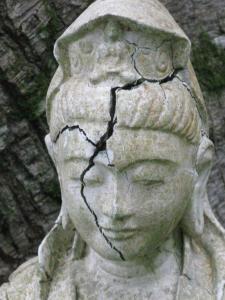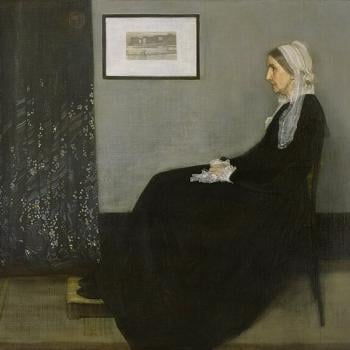I’ve been asked if I could say in a nutshell what it is about Zen in the West that makes it worth preserving?
A fair question, and for a number of reasons. Among them we find ourselves in a moment of major shifting where the founding generation of practitioners are not only aging but beginning to die. Zen has now been a serious if minority tradition in the West for better than fifty years. Not a bad time for some assessment. So, what beyond what looks like the probability our next generation of Western practitioners will be smaller than the previous one, do we have that is that worth preserving?
The Zen emerging in the West is both a faithful carrier of something ancient and beautiful, and at the same time substantially different than the Zen of its East Asian parents.
The heart of what we’re receiving from East Asia is two-fold. First, it is a way of seeing, and out of that a perspective on how to live in this world. And second there are some practices that the tradition brings along. Most importantly, two. One consists of some closely constellated disciplines that here I’ll call zazen, or seated Zen meditation. The other is another set of constellated practices I’ll call koan study.
We have from the beginning adapted those two things to our culture. There are always unique things regarding the container of Zen. And even as I write that word “container,” I’m uncomfortable how it can make these things seem unimportant. They are in fact critical. They address how Zen is presented, preserved, and transmitted. These things usually cluster into cultural styles. So, we see Chinese forms, Korean forms, Vietnamese forms, and Japanese forms. Each of these can be startlingly different. And, so, of course, there are the emerging ways unique to our Western cultures and as a subset our North American culture.
From that I would say we in the West offer two gifts and one very large challenge.
The first of these unique gifts of Zen in the West is the “Zen center.” The term itself was coined by students of the Japanese Zen missionary to San Francisco, the late Shunryu Suzuki. It represents a major shift in the locus of practice from monastery to lay practitioners. While there are and always have been lay Zen practitioners, they’ve always been at the edges of the monastic focus. Here that is no longer the case. The majority of people who practice Zen are laypeople and their communities are structured as Zen centers.
The second is gender equality and with it an egalitarian bias. In East Asia, again there have always been women practitioners, but they have been marginalized. Too often even the literature reduces them to unnamed “tea ladies,” who the aspiring teacher meets, is bested by, and then who asks where he, always a he, might find a suitable teacher? She, almost always a she then points them on. Today women and men seem to practice in near equal numbers here and surveying the names of the more prominent women teachers it looks like there is pretty solid parity. Not a done deal, not by a long shot. But, the quest for gender equity in practice in Western Zen is more than aspirational. Similarly sexual minorities have found a place within Zen practice that is unusual among the larger religious communities in the West. Again, we are at a better than aspirational stage.
Now, the unique characteristics of Zen come West are rather more than those two I hold up as great gifts. I think Stephen Slottow captures the essence of those features common to Zen in the West. With a slightly different ordering, 1) Vastly greater gender inclusivity. 2) An emphasis on lay and non-monastic practice. 3) De-emphasizing ritual and other traditional temple aspects of religious life. 4) The lack of substantial overarching denominational structures. 5) Deemphasizing of merit, its creation and its transference as central to practice.
The first two in that list are those unique gifts I noted above.
The following three while presented descriptively present what I consider are profound difficulties. Here we find that term “container.” And, here we find a challenge.
In East Asia Zen Buddhism arrived seeking support from authoritarian leaders who had the ability to either support or suppress. It was critical for them to be seen as useful to the state in some manner. Often this turned on the dedication of merit to benefit the leaders as well as the general well-being of the community. And these aspects of religion as holders of culture are historically critical to the “success” of a religion. Of course, they are also in many ways problematic, often the central locus of how a culture defines who is in and who is out.
Then. Now. Here, Zen encountered bourgeois republics with declining interest in religion. Here new problems emerge. The way we are organized makes our communities pay-as-you-go and the pressures to support the emerging sanghas and their teachers can and sometimes do compete in the hearts of the practitioners with basic survival. As a result it is hard to be poor, or even just struggling financially and be a serious Zen practitioner – in the sense of participating regularly and especially attending retreats.
Similarly, the first people attracted to Zen in the West have been from the dominant European descent community. The issues of race burns hot in the hearts of many current practitioners wanting to be more broadly inclusive. And we have arrived at a moment where the first Zen priests and teachers of African descent are emerging. But, whether Zen largely “belongs” or, at least seems to belong to the White middle class is a real question. In a culture driving relentlessly toward multi-racial, multi-cultural direction, the very survival of the tradition may be bound up with how open the Zen centers really are.
And, more. I’ve saved the biggest of the questions for last. And with that the challenges clustered around the question of whether Zen is spiritual or religious? Zen at its bare bones, those two things of a way of seeing, and those practices, is all pretty wide open. It is sometimes hard to see the container. You certainly don’t have to be a “Buddhist” to embrace Zen’s sense of awakening or its practices. This is one reason why Zen has been so attractive to a number of Christians and is central to the emergence of what might best be called a nondual Christianity. But, even more challenging is the meeting of Zen, its perspective on awakening and its practices and Western psychology. (For instance) This has been a complicated issue for Buddhism come West, but it is also very much so for Zen in the West, where it is easy for Zen simply to become a psychological modality, a part of a larger project of therapy.
So, in summary. The closest I come to that matchbook. Our Western Zen is committed to bringing an ancient understanding of awakening to the West and with that some powerful disciplines. Zen practitioners here have organized ourselves mainly as communities of lay practice within Zen centers, committed to greater egalitarianism and the equality of people.
But then there’s the other side of the matchbook. And with that a larger question of identity and with it of mission.
And taking those last things together, perhaps the critical question for our long term survival. Are we in fact a religion?
And what that means and will mean…













